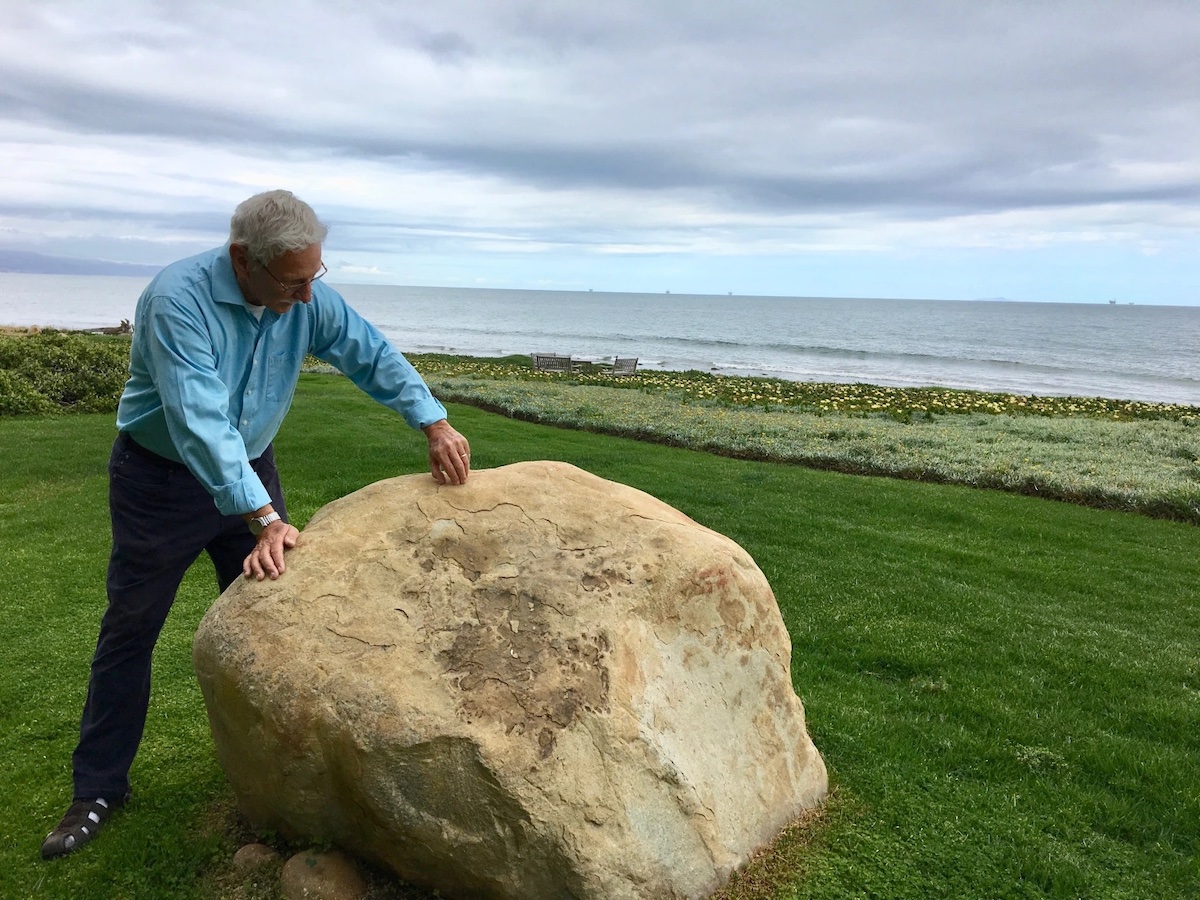A Farewell to Ed, the Boulder Hunter
An Enthusiast About the Ground Beneath Our Feet

The last time I worked on a story for the Indy about Ed Keller, the UCSB geologist who died in early September, it was the spring of 2019, and he was driving around Santa Barbara, calculating the age of prehistoric debris flows by looking at “neat boulders” — thousands of them. They were still in place, right where they had dropped out of rivers of mud and rock, ages ago.
Ed and his students were measuring the thickness of the oxidized crust or “weathering rind” that had built up on these boulders after they had been scraped clean by the prehistoric flows. Ed said he got so proficient, he could tell at a glance whether their crusts were geologically “young,” of “intermediate age,” or “very old,” that is, one or two inches thick and cracked like the shell of a turtle, signifying a debris flow more than 100,000 years old.
“You’ll never look at boulders the same way!” he said.
Ed scrutinized boulders at the Botanic Garden; Stevens, Rocky Nook, Oak, and Orpet parks; the county courthouse; Westmont College; in stone walls along Garden and Laguna streets, and down in the canyon behind his home on Las Canoas Road. He found boulders on the Riviera from a flow 125,000 years old, before the Riviera ridge was uplifted by earthquakes. He was so excited, he said it was like hunting for giant Easter eggs.
In the midst of his research, Ed sent me an urgent email: he had had an epiphany!
“Hi Melinda go to south end of Oak Park and see 6 ft high boulder. Go across street into the apartments and see many boulders from Rocky Nook flow. ED Attached is a poem that sums up my philosophy [and] the old saying, I was blind and now I see.
“Until I looked I never appreciated the role of debris flows in our landscape. ED”
LISTEN TO THE EARTH
Listen to the Earth. It speaks to us and we connect with the wonder and magic of the land
Our listening can remove the mystery, but never the magic
Imagine the mountains as they change with each debris flow, landslide, flood or earthquake
Rocks humming from above and below.
Rumbling from flood, landslide, debris flow or earthquake
with the sound of thunder of an approaching freight train
Forced up to the surface
Fracturing and weathering
Moving ever toward the sea
Go to the wild on a mountain top or along a river, and shout, “Earth Speak to Me”
If Earth doesn’t answer, meditate deeper and ask again
Listen to the Earth it speaks to us All we must do is listen
Ed Keller 6/12/19
That was the thing about Ed: He loved geology and enthusiastically sought to educate all of us about the ground under our feet — an education that has become imperative in the wake of the deadly debris flow of January 9, 2018, in Montecito.
In 2019, Ed showed me the path of a prehistoric debris flow about 1,000 years old that he discovered on Montecito Creek, from Hot Springs Creek to Haskell’s Beach, where the creek once flowed into the ocean. (He believed it was the second-to-last major debris flow in Montecito, though more recent research has challenged that view.) On the beach, we walked over to Bonnymede and looked at boulders from the same event on the lawn of the condominium complex.
As a local reporter, I always looked forward to hearing about Ed’s latest findings: the prehistoric channels intersecting Laguna Street, the 30-foot-deep debris flow deposit under Rocky Nook, the accelerating rate of sea cliff erosion in Isla Vista. One of the books he wrote is titled Santa Barbara, Land of Dynamic Beauty: A Natural History.
It was just a blast to go slogging around with Ed. He was always so upbeat and eager to spread the word. I did my best to keep up with him.
From my files, I’ve unearthed the story I wrote back in 2001 about a debris flow several thousand years old in Rattlesnake Canyon that Ed was studying. Judging from the boulders at Rocky Nook, Skofield, and Oak parks, he said, the flow was one of the largest in Southern California history and “would have sounded like a thousand thunders.” If it happened again, he added, “The loss of life would be catastrophic.”
“You need to be aware that these things happen and have some plans about what you would do,” Ed said — a prescient warning if ever there was one.
I extend my heartfelt sympathy to all of Ed’s family; I will miss my old friend and guide very much.
The university is hosting an Aloha Celebration for Ed Keller from 2-5:30 p.m. on Saturday, December 3 on campus at the Betty Eling Wells Pavilion at the Faculty Club. Tickets can be reserved here: https://www.eventbrite.com/e/ed-kellers-aloha-celebration-tickets-465453141877
Melinda Burns is an investigative journalist with 40 years of experience covering immigration, water, science and the environment. As a community service, she offers her reports to multiple publications in Santa Barbara County, at the same time, for free.



